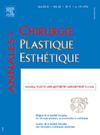Thrombotic thrombocytopenic purpura following plastic surgery: A case report
IF 0.5
4区 医学
Q4 SURGERY
引用次数: 0
Abstract
Thrombotic thrombocytopenic purpura (TTP) is a rare and life-threatening condition characterized by thrombocytopenia, microangiopathic hemolytic anemia, and potential multi-organ involvement. Typically, TTP is associated with underlying conditions such as autoimmune diseases, infections, cancer, or hereditary factors. To date, very few cases of post-operative TTP have been reported. We report the first known case of TTP following plastic surgery. A 19-year-old female initially recovered uneventfully after breast reduction surgery but presented on postoperative day 7 with a persistent hematoma, worsening anemia, and thrombocytopenia. The diagnosis of TTP was confirmed following hematoma evacuation, with laboratory results showing severe hemolysis and a marked reduction in ADAMTS13 activity. The patient was promptly treated with plasma exchange, corticosteroids, and rituximab, which led to significant clinical improvement and resolution of hematological abnormalities. This case underscores the rarity of TTP following plastic surgery, where it is more often linked to other medical conditions. Early recognition and management of TTP, particularly with plasma exchange, are crucial to preventing complications and improving patient outcomes. Although endothelial damage during surgery may contribute to the onset of TTP, the causal link in this case remains uncertain. Awareness of TTP as a potential postoperative complication is essential, especially when dealing with persistent anemia, bleeding, or thrombocytopenia.
Le purpura thrombotique thrombocytopénique (PTT) est une affection rare et potentiellement mortelle caractérisée par une thrombocytopénie, une anémie hémolytique microangiopathique et une possible atteinte d’organes. Le PTT est généralement associé à des pathologies sous-jacentes telles que des maladies auto-immunes, des infections, des cancers ou des prédispositions héréditaires. À ce jour, très peu de cas de PTT postopératoire ont été rapportés. Nous rapportons le premier cas de PTT survenant après une intervention de chirurgie plastique. Une patiente de 19 ans, ayant bénéficié d’une plastie mammaire de réduction sans complication initiale, s’est présentée au septième jour postopératoire avec un hématome, une anémie et une thrombocytopénie. Le diagnostic de PTT a été confirmé après l’évacuation de l’hématome, les résultats biologiques montrant une hémolyse sévère et une réduction marquée de l’activité d’ADAMTS13. La patiente a été rapidement traitée par échanges plasmatiques, corticostéroïdes et rituximab, ce qui a conduit à une régression rapide des symptômes et à une résolution des anomalies hématologiques. Ce cas met en évidence la rareté du PTT après une intervention chirurgicale, cette affection étant généralement liée à d’autres pathologies médicales sous-jacentes. La reconnaissance précoce et la prise en charge du PTT, en particulier par échanges plasmatiques, sont cruciales pour prévenir les complications et améliorer le pronostic des patients. Si les lésions vasculaires endothéliales survenues pendant la chirurgie peuvent contribuer à l’apparition du PTT, la physiopathologie du PTT postopératoire reste à démontrer. Il est essentiel de considérer le PTT comme une complication postopératoire possible, en particulier face à une anémie marquée, un hématome persistant ou récidivant, ou une thrombocytopénie.
整形手术后血栓性血小板减少性紫癜1例报告。
血栓性血小板减少性紫癜(TTP)是一种罕见且危及生命的疾病,其特征是血小板减少,微血管病溶血性贫血,并可能累及多器官。通常,TTP与自身免疫性疾病、感染、癌症或遗传因素等潜在疾病有关。迄今为止,很少有手术后TTP病例的报道。我们报告第一例已知的TTP后整形手术。一名19岁女性在缩胸手术后最初恢复平稳,但在术后第7天出现持续血肿,贫血恶化和血小板减少。血肿清除后确诊TTP,实验室结果显示严重溶血和ADAMTS13活性显著降低。患者及时接受血浆置换、皮质类固醇和利妥昔单抗治疗,临床显著改善,血液学异常得到缓解。这个病例强调了整形手术后TTP的罕见性,它通常与其他医疗条件有关。TTP的早期识别和管理,特别是血浆置换,对于预防并发症和改善患者预后至关重要。尽管手术期间内皮损伤可能导致TTP的发生,但本病例的因果关系尚不确定。意识到TTP作为潜在的术后并发症是必要的,特别是在处理持续性贫血、出血或血小板减少症时。
本文章由计算机程序翻译,如有差异,请以英文原文为准。
求助全文
约1分钟内获得全文
求助全文
来源期刊
CiteScore
1.00
自引率
0.00%
发文量
86
审稿时长
44 days
期刊介绍:
Qu''elle soit réparatrice après un traumatisme, pratiquée à la suite d''une malformation ou motivée par la gêne psychologique dans la vie du patient, la chirurgie plastique et esthétique touche toutes les parties du corps humain et concerne une large communauté de chirurgiens spécialisés.
Organe de la Société française de chirurgie plastique reconstructrice et esthétique, la revue publie 6 fois par an des éditoriaux, des mémoires originaux, des notes techniques, des faits cliniques, des actualités chirurgicales, des revues générales, des notes brèves, des lettres à la rédaction.
Sont également présentés des analyses d''articles et d''ouvrages, des comptes rendus de colloques, des informations professionnelles et un agenda des manifestations de la spécialité.

 求助内容:
求助内容: 应助结果提醒方式:
应助结果提醒方式:


